Asian art is gloriously basking in the sun this year. While 42 extraordinary galleries from around the globe open their doors with one-of-a-kind exhibitions during Asia Week New York, The Metropolitan Museum of Art is celebrating the centennial of its world-renowned Department of Asian Art. Even Vogue editor-in-chief Anna Wintour jumped on the bandwagon as she recently visited Beijing to promote the Met Costume Institute’s upcoming exhibition China: Through the Looking Glass.
Works of art from all over the Asian continent and spanning over four millennia will be shown throughout Manhattan by international Asian art specialists during Asia Week New York, starting March 13 to March 21, 2015. Art lovers can take in museum-caliber treasures including the rarest and finest Asian examples of painting, sculpture, bronzes, ceramics, jewelry, jade, textiles, prints and photographs from all over Asia.
Says Carol Conover, Chairman of Asia Week New York 2015: “This year is especially meaningful for Asia Week New York, since it coincides with the 100th anniversary of the incomparable Department of Asian Art at The Metropolitan Museum of Art. Asia Week New York always creates excitement, and never more than this year. For six years, Asia Week New York has pursued its singular mission of integrating Asian art into the cultural fabric of New York and promoting its unique appeal worldwide.
Organized by category, here is a roundup of the not-to-be-missed exhibitions at the participating galleries:
CHINESE, ANCIENT THROUGH CONTEMPORARY ART
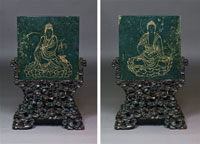 |
In an exhibition called Treasures from the Middle Kingdom, the Los Angeles-based Asian Art Studio features a pair of extremely rare and magnificent 18th-century imperial spinach-green jade screens on the 7th floor of the Fuller Building, 41 East 57th Street. The screens bear the inscription “Respectfully Painted by Your Majesty’s Servant Zhao Bingchong,” who was a court painter of the late Qianlong era. |
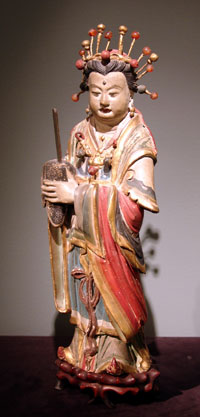 |
On the 12th floor of the Crown Building at 730 Fifth Avenue, Ralph M. Chait Galleries, Inc. is putting forth a Spring Exhibition of Chinese Art to include a majestic 14-inch Chinese stucco figure of an immortal, superbly modeled in the three-quarter round, wearing a jeweled tiara and holding a guei (tablet of rank). It dates from the Yuan-Ming Dynasty, circa the 14th to the 16th century. |
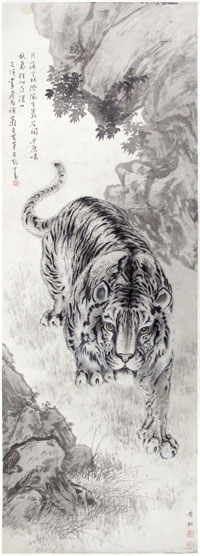 |
China 2000 Fine Art, at 177 East 87th Street, aims a spotlight at Prowling Tiger, one of the works in an exhibition devoted to artist An Ho (born 1927) and titled Two Sides of the Same Coin. This particular work is the sole collaboration by An Ho and her teacher, Master Pu Ru (1896-1963), who created the background of the painting. The exhibition includes a number of paintings by An Ho with inscriptions by Pu Ru and paintings by Pu Ru with inscriptions by An Ho. |
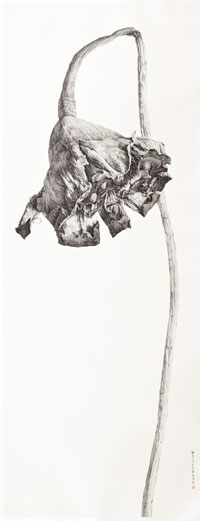 |
In its Chinese contemporary ink painting show Winter Lotus Garden, The Chinese Porcelain Company at 475 Park Avenue is highlighting its newest artist, Zhao Xu, from Beijing. His Lotus Pod II of 2014 depicts a massive lotus pod during winter in China with remarkable and delicate detail. |
 |
Wood, traces of polychromy and gilding embellish a large, delicately refined wood sculpture of Guanyin from the Song Dynasty (960-1279) in From this Life to Eternity, the exhibition that Gisèle Croës of Brussels is setting up at the Gagosian Gallery, 980 Madison Avenue. This work features the Bodhisattva of Compassion, the most popular Bodhisattva in Buddhism.
|
 |
In its exhibition of Selected Works of Chinese Furniture, Sculpture and Scholars’ Objects, Nicholas Grindley Works of Art Ltd., will feature a pair of stone lokapala heads at Hazlitt, Gooden & Fox Ltd, 17 East 76th Street. The lokapala, literally meaning world (loka) and guardian (pala), watched over Buddhist temples and altars and were frequently buried in tombs for the journey to the afterlife. For some reason, stone and marble versions hardly ever survived unlike their much more common pottery examples, making this complete pair in sandstone astonishingly rare. These compelling heads depict all of the aggression one would expect in fierce guardian figures dating from the late Tang or early Five Dynasties. |
 |
Though primarily a Chinese specialist, Michael C. Hughes LLC will also offer some fascinating objects from Korea and India in his exhibition Chinese, Indian and Korean Works of Art at Shepherd W & K Galleries, 58 East 79th Street. One of his highlights is a rare five-inch Korean brush pot from the Choson Dynasty. This simple and austere piece, intended for a scholar’s writing desk, is delicately but sparingly painted with sprays of aster, carnation, orchid and lily rising from rockwork set in jardinières. |
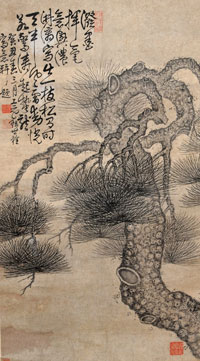 |
Jadestone of Portland, Oregon, is pulling the curtain back on a painting dating from 1733 as part of its Scholarly Pursuits exhibition in Suite 704 of the Fuller Building, 41 East 57th Street. Not much is known of the artist, Qian Shiquan, but he had a whimsical and anthropomorphic way of depicting nature (one part of a tree resembles the body of an elderly scholar) that makes his surviving work singular and unforgettable. |
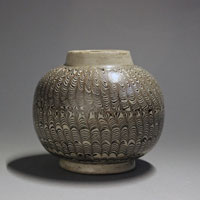 |
In his exhibition, Chinese Ceramics and Works of Art, at The Mark, 27 East 77th Street, Andrew Kahane, Ltd. will showcase a group of eight Song period ceramics from a distinguished American collection. Among them is a rare marbled globular jar, which employs the jiao tai (mixed clay) technique, using layered ivory and dark brown colored clays which are twisted into a 'feather' pattern to construct the vessel. Made from hemispherical halves luted together under a transparent glaze, the distinctive form is closely related to the body of the well-known ewer in the Alfred and Ivy Clark Collection. |
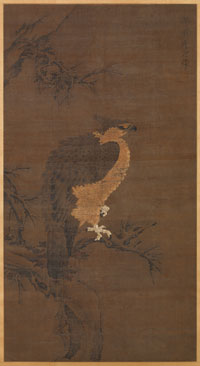 |
A hanging scroll format is an elegant solution for displaying and storing a painting, and Eagle on Winter Branch, a rare 13th 14th century scroll, is one of the important works that can be seen at Kaikodo LLC's exhibition Elegant Solutions: Chinese and Japanese Works of Art and Paintings at 74 East 79th Street, Suite 14B. |
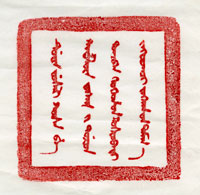 |
A rare imperial Chinese silver seal surmounted by a tiger is one of the highlights at an exhibition of Chinese Art from the Scholar’s Studio presented by J.J. Lally & Co. at 41 East 57th Street, 14th Floor. The very heavily cast seal is a solid silver emblem of rank which was bestowed upon the leader of a Mongol clan by the Emperor Kangxi in 1686. The seal was granted as the official symbol of the elevation of the Mongol clan leader to the rank of prince (zhasake) in fealty to the Chinese emperor with the right to rule over his clan and territory in Mongolia. |
 |
On the second floor of 55 East 80th Street, M. Sutherland Fine Arts, Ltd. is featuring contemporary Chinese ink paintings. Drawing his inspiration from the breathtaking views of the Taroko Gorge region in eastern Taiwan, artist Hsu Kuohuang captures the drama of the vertiginous cliffs and thundering streams coursing through the gorge in The Pen Follows Where the Mind Wanders, Number 1. His wild, expressive brushwork has a remarkable confidence, using techniques directly derived from his lifelong practice of calligraphy. |
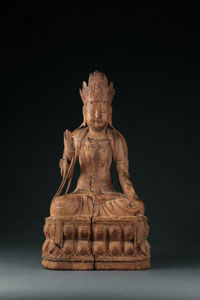 |
Wei Asian Arts of Brussels is displaying its Latest Acquisitions and a Collection of Scholars’ Objects on the ground floor of the Tambaran Gallery at 5 East 82nd Street. There, visitors can delight in a Bodhisattva Avalokitesvara from the Late Yuan-Early Ming Dynasty. Carved from a single block of wood, this treasure from China shows Avalokitesvara seated in a meditative posture on a high lotus base, the legs draped in a loose skirt, leaving the torso bare but for a thin shawl across the shoulders. |
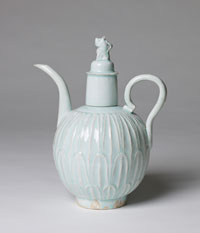 |
A porcelain ewer with ovoid body, deeply carved with lotus petals in two bands overlapping at the body’s mid-section, is the unforgettable piece that Eric Zetterquist will unveil at his gallery at 3 East 66th Street, Suite 1B in a show of Chinese Ceramics. This millennium-aged pitcher, which has an upright form and is covered with a beautifully realized translucent pale blue Qingbai glaze. |
SOUTHEAST ASIAN, INDIAN, HIMALAYAN, ANCIENT THROUGH CONTEMPORARY
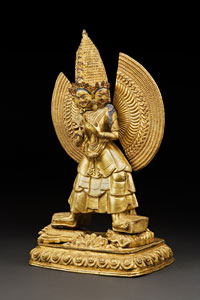 |
Walter Arader Himalayan Art at 1016 Madison Avenue has singled out this impressive Sitatapatra for his exhibition, Fine Himalayan Art. With its impressive size, high-quality craftsmanship, and exceptional provenance, this piece was most likely completed during the reign of Qianlong for a Gelugpa commission as the cult of Sitatapatra was burgeoning at this time. |
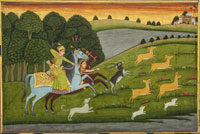 |
The painting of Baz Bahadur and Rupmati Out Hunting, a circa-1750 painting executed with exquisite detail set against a golden sky, exhibits a luminous quality that is reminiscent of works by the celebrated 18th-century artist Mir Kalan Khan. It is part of an exhibition of more than 20 paintings entitled The Feminine Mystique in Indian Art, an alluring show to be unveiled by San Francisco's Art Passages at Isselbacher Gallery, 41 East 78th Street. |
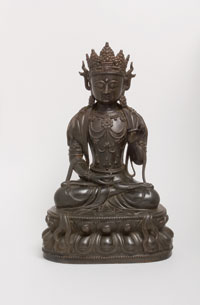 |
Dr. Robert R. Bigler of Switzerland is showcasing a fine, nearly one-foot-tall dark bronze casting of Guanyin from 14th-century China. It is one of many attention-grabbing pieces in Before Yongle: Chinese and Tibeto-Chinese Buddhist Sculpture of the 13th and 14th Centuries at Dickinson Roundell, Inc., East 66th Street. |
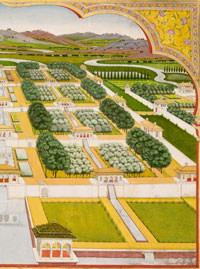 |
Depicting one of the world’s finest gardens, A View of Shalimar Bagh is a watercolor leaf from a circa-1780 gold-embellished album made for Antoine Polier, in the fabled city of Lucknow. It is required viewing at The Flower Garden: Indian Paintings 1600-1850, the exhibition that London’s Prahlad Bubbar is bringing to the Arader Galleries at 1016 Madison Avenue. |
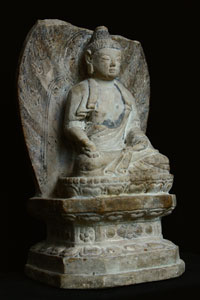 |
Berlin’s Buddhist Art showcases a splendid 15th-century marble Buddha Baisajyaguru. On view at Arader Galleries at 29 East 72nd Street, in an exhibition of Recent Acquisitions, the piece is a must-see because it is clearly identified as coming from the Diamond Seat Pagoda in Beijing, and it is very rare that a sculpture of this type can be traced to an individual temple site. |
 |
At the Arader Galleries located at 1016 Madison Avenue, in an exhibition of Latest Acquisitions, Carlo Cristi of Daverio, Italy, will display a 17-inch copper anthropomorphic figure from India’s Gangetic Valley that dates to around 1500 B.C. This beautiful objet d’art might possibly have been a ritual offering during the Vedic period. |
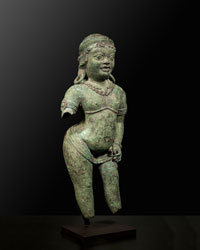 |
Milan’s Dalton Somaré will present an extremely rare bronze 5th-to-6th-century image of a vegetal Godling in their exhibition of Recent Acquisitions at Friedman & Vallois Gallery on the second floor of 27 East 67th Street. Associated with richness, fertility and soil, this deity has been worshipped since the pre-Arian times and was eventually absorbed into the mythology of Buddhism and Hinduism. |
 |
The not-to-be-missed artwork that Oliver Forge & Brendan Lynch Ltd. are bringing from London is a portrait of Emperor Farrukhsiyar, a little-known potentate who ruled from 1713 to 1719. On display at 9 East 82nd Street, Suite 1A, this superb work dates from 1715 and is part of a show entitled Indian Painting 1590-1870. Ascribing paintings to this art-patronizing emperor’s reign is difficult because it was so short. Here, he is depicted in all the traditional splendor of a royal prince: heavily jeweled turban, a robe with flowers, a sash of gold and ropes of pearls around neck, waist and arms. |
 |
Standing out among works in the Indian Painting exhibition that London’s Francesca Galloway is hanging on the walls of W.M. Brady & Co., 22 East 80th Street, is an exquisite watercolor on paper of two Hindu courtiers conversing. The painting, from Ahmadnagar, dates to the end of the 16th century. Paintings from Ahmadnagar belong to the rarest of the Deccani schools and have been the most elusive to reconstruct. There has always been strong interest in the arts of the Deccan because it is a melting pot of Mughal, Persian, Ottoman and Hindu artistic ideas. |
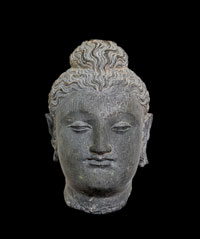 |
A spectacular Gandhara head of Buddha in grey schist, circa 2nd century AD is among the many outstanding treasures in Arts of India and Nepal and Dong Son Bronzes, presented Paris-based Galerie Christophe Hioco, at Arader Galleries, 1016 Madison Avenue. |
 |
A contemporary work by award winner Ru Yi Tan entitled Unpredictable Day shines in My Country, an exhibition by Shalini Ganendra Fine Art of Kuala Lumpur. This mixed-media diptych on wood can be seen at the Bernarducci Meisel Gallery, 37 West 57th Street, 3rd Floor, and is, in the words of the artist, “A celebration of experimentation with the everyday. That is what I do and the everyday incorporates Malaysian and Japanese, both of which are my points of origin.” |
 |
Nayef Homsi Ancient Art of Asia at 7 East 75th Street, Unit 1A, is mounting an exhibition of Recent Acquisitions that features a stunning bust of Bodhisattva carved from polished dark blue schist. Extremely rare, this 2nd-century Gandhara stone was an important commissioned work with finely carved facial features, as well as elaborate hair and jewelry design. |
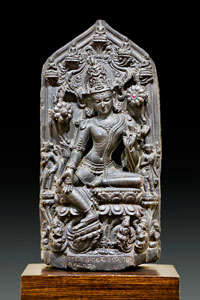 |
An 18-inch Avalokitesvara from eastern India, circa 12th century, compels scrutiny in Realms of Existence: Buddhist and Hindu Works of Art, the exhibition at Kapoor Galleries on the 3rd floor of 34 East 67th Street. A powerful example of the unknown artist’s skill in rendering a sensuous image with great aplomb, this Avalokitesvara, the Buddhist bodhisattva of compassion, exemplifies the beauty and complexity of the Pala style of art. |
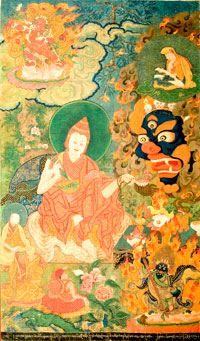 |
Navin Kumar Gallery in Suite 4F at 24 East 73rd Street is parading an array of treasures in its exhibition Indian and Himalayan Art. Among them is an important 18th-century Thangka painting of Dorje Pal illustrating him in a mountainous landscape, seated on a tiger skin, holding a kila in his right hand and extending a skull cup towards a wrathful deity with his left. |
 |
Amid the riches in A World of Jewels: Jewels from Central Asia, China, India, South East Asia and Indonesia a ruby and gold snake ring sparkles and mesmerizes. This finely worked 19th-century South India bijou, on view on the 7th floor of 23 East 73rd Street, comes from Susan Ollemans Oriental Art of London, and shows a serpent inset with rubies and diamonds with blue sapphires as the eyes and tongue. |
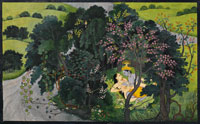 |
Indian, Himalayan and Southeast Asian Art Featuring a Collection of Classical Indian Paintings at Carlton Rochell Asian Art, 121 East 71st Street, 2nd Floor, includes a must-see illustration of a Gita Govinda. Dating from about 1775 and attributable to a master of the first generation after Nainsukh, this opaque watercolor is all the more eye-catching because it is embellished with gold. Based on the great lyric poem by Jayadeva, this artwork illustrates Radha and Krishna in a bower and was commissioned for the wedding of the great ruler Sansar Chand. |
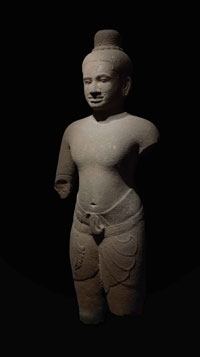 |
At the forefront of top-liners in the Acquisitions 2014 exhibition at Nancy Wiener Gallery in Suite 10-18 of the historic Ansonia, 2109 Broadway, is a large likeness of the important Hindu god Shiva. One of few surviving sculptures of this scale and quality from 11th-century Khmer, it is finely carved in the round and shows the deity’s countenance in an expression of ideal serenity. |
JAPANESE, ANCIENT THROUGH CONTEMPORARY ART
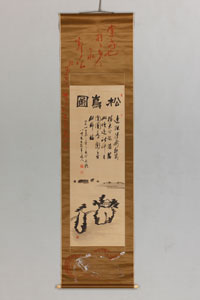 |
The Three Landscapes of Japan by Tanomura Chokunyu (1814-1907) and Tomioka Tessai (1836-1924) claim special attention in Japanese Art|Pre-Modern and Beyond, the exhibition that BachmannEckenstein JapaneseArt of Basel, Switzerland, presents at Gallery Schlesinger on the second floor of 24 East 73rd Street. Representing a rare kind of collaboration, with Chokunyu’s painting and Tessai’s mounting, the piece shows views of the pine-clad islands of Matsushima and sandbar of Amanohashidate, along with the Itsukushima Shrine in Hiroshima Prefecture. |
 |
New York’s Dai Ichi Arts, Ltd., takes pride in presenting The Grandeur of Japanese Ceramics: From Tea Ware to Sculpture at Hollis Taggart Galleries, 958 Madison Avenue. Their exhibition will feature a wide range of contemporary Japanese ceramics that re-examine notions of tradition, in both glaze and form, from upcoming stars to Living National Treasure’s master pieces. Singled out for definite notice is a 1960s ceramic sculpture vessel by Suzuki Osama (1926-2001), one of the founders of the important Japanese avant-garde ceramist group Sodeisha. |
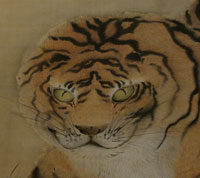 |
Tigers in Japanese art are iconic images, and exemplifying this is an imposingly large scroll, 33 inches wide and 57 inches high, that was created in 1769 by the revered artist Maruyama Okyo and that shows a pair of dramatic tigers in landscape setting, their fur carefully rendered. The scroll is part of Carole Davenport’s exhibition Fabulous Beings: Japan & China & Sculpture by Hiroyuki Asano, on view at Leigh Morse Fine Arts on the fifth floor of 22 East 80th Street. |
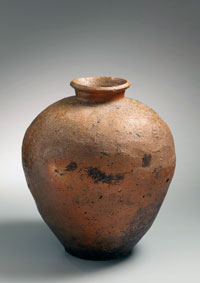 |
At Joan B. Mirviss, Ltd., 39 East 78th Street, the exhibition Tsubo: The Art of the Vessel celebrates the unparalleled and unbroken history of Japanese ceramics, focusing on the classic form of the tsubo, or storage vessel, as it has been interpreted through 2,000 years of ceramic history. In addition to their ancestral and poetic associations, for the past 60 years, the large, bold tsubo forms have provided the perfect platform for innovative artistic experimentation, whether playful or reverential, for traditional masters and avant-garde Japanese ceramists alike. |
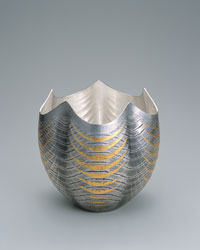 |
Female metal artists in Japan are very uncommon, making Yukie Osumi’s 2009 hammered silver vase entitled Underwater Dragon a must-see at Onishi Gallery’s Heritage: Contemporary Japanese Ceramics and Metalwork, on display at Erarta Galleries on the first floor of 1043 Madison Avenue. Osumi is unquestionably one of the very best practitioners of contemporary metal art, and her work is in the permanent collection of the Victoria and Albert Museum. |
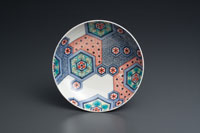 |
Giuseppe Piva Japanese Art of Milan is unfurling 400 Years of Japanese Art at 24 East 80th Street. Not to be overlooked in this amazing panoply of objects is a Nabeshima dish from the Early Edo period (late 17th century). This stunning piece is decorated with an underglaze of blue, red, green and yellow enamel in an irregular hexagonal pattern.
|
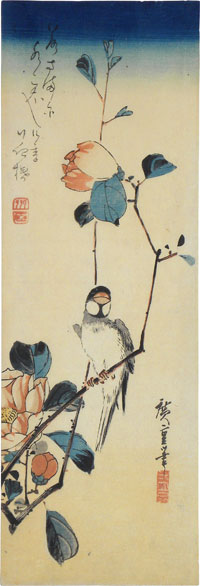 |
In Suite 6D of 145 West 58th Street, Scholten Japanese Art presents Kacho Fugetsu: Natural Beauty in Japanese Art, an exhibition devoted to images of nature. Of prime focus is a circa-1830s woodblock print titled Java Sparrow and Camellia, by Utagawa Hiroshige (1797-1858), one of the best-known Japanese artists of the 19th century. The work depicts an expressive bird cocking its head ever so slightly at an angle while entrapping the viewer's gaze. |
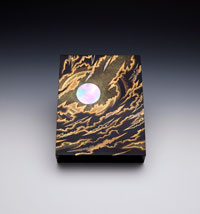 |
At only 37, Okada Yoshio has already mastered the demanding traditional techniques required of artistry in lacquer, as evidenced by his Box with Moon and Clouds, which has prominence in Taisho Era Screens and Scrolls, the exhibition at Erik Thomsen Gallery on the fourth floor of 23 East 67th Street. Gold, silver and an attention-commanding full moon fashioned from a slice of shell are among the deft embellishments inside and outside this extraordinary box. |
 |
Recent Acquisitions is the title of the exhibition by Kyoto’s Hiroshi Yanagi Oriental Art at Arader Galleries, 1016 Madison Avenue, and among those items a Head of a Deva deserves special notice. It dates from the late Heian period (12th century) and is crowned with a helmet. The fearsome expression is enhanced by the angry-looking eyes and open mouth, a rare attribute for this deity, Kōmokuten. |
KOREAN, ANCIENT THROUGH CONTEMPORARY
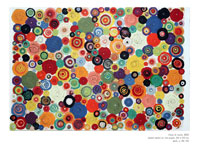 |
Layers of burnt rice paper and colors taken from traditional cosmic philosophy create an experience of emotion communicated through abstract language in Pieno di vuoto, a 2005 work by Minjung Kim that holds a special place among Happy Modern and Contemporary Korean Paintings at Kang Collection Korean Art on the third floor of 9 East 82nd Street. Kim’s painting evokes, among other references, Kandinsky and American feminist art. |
 |
Thousands of tiny burnt incense holes pierced onto rice paper are evidence of an incredibly patient hand in a series of recent large-scale artwork by Jihyun Park. This inventive medium is highlighted at KooNewYork's exhibition Choson and Contemporary Korean Art, on the ground floor of the Tambaran Gallery, 5 East 82nd Street. The exhibition also includes wood kiln-fired modern ceramics by the renowned master potter Inchin Lee, alongside choice antique works from Korea's long Choson Dynasty (1392-1910).
|
ABOUT ASIA WEEK NEW YORK
The collaboration of 42 top-tier international Asian art specialists, five major auction houses: Bonhams, Christie’s, Doyle New York, iGavel, and Sotheby’s and 21 museums and Asian cultural institutions, Asia Week New York is a week-long celebration filled with a non-stop schedule of simultaneous gallery open houses, Asian art auctions as well as numerous museum exhibitions, lectures, symposia, and special events.
Participants from Belgium, England, France, Germany, Italy, Japan, Malaysia, Switzerland, and the United States unveil an extraordinary array of treasures from China, India, the Himalayas, Southeast Asia, Tibet, Nepal, Japan, and Korea.
A comprehensive guide with maps will be available at participating galleries, auction houses and cultural institutions, starting February 2015 and online at asiaweekny.com. Emphasizing the strength of interest from Chinese-speaking buyers, a Chinese version of the website is available at cn.asiaweekny.com.
Asia Week New York Association, Inc. is a 501(c)(6) non-profit trade membership organization registered with the state of New York.
For additional information visit: www.asiaweekny.com and follow on Facebook Twitter, and Instagram @asiaweekny.
ABOUT ASIA WEEK NEW YORK PRESENTING SPONSOR: AMAN
Aman was founded in 1988 with the vision of building a collection of intimate retreats with the unassuming, warm hospitality of a gracious private residence. The first, Amanpuri (place of peace) in Phuket, Thailand, introduced the concept, and since then, Amanresorts has grown to encompass 26 resorts located in Bhutan, Cambodia, China, France, Greece, Indonesia, India, Laos, Montenegro, Morocco, the Philippines, Sri Lanka, Thailand, Turkey, the Turks & Caicos Islands, the USA and Vietnam. For more information, visit amanresorts.com
